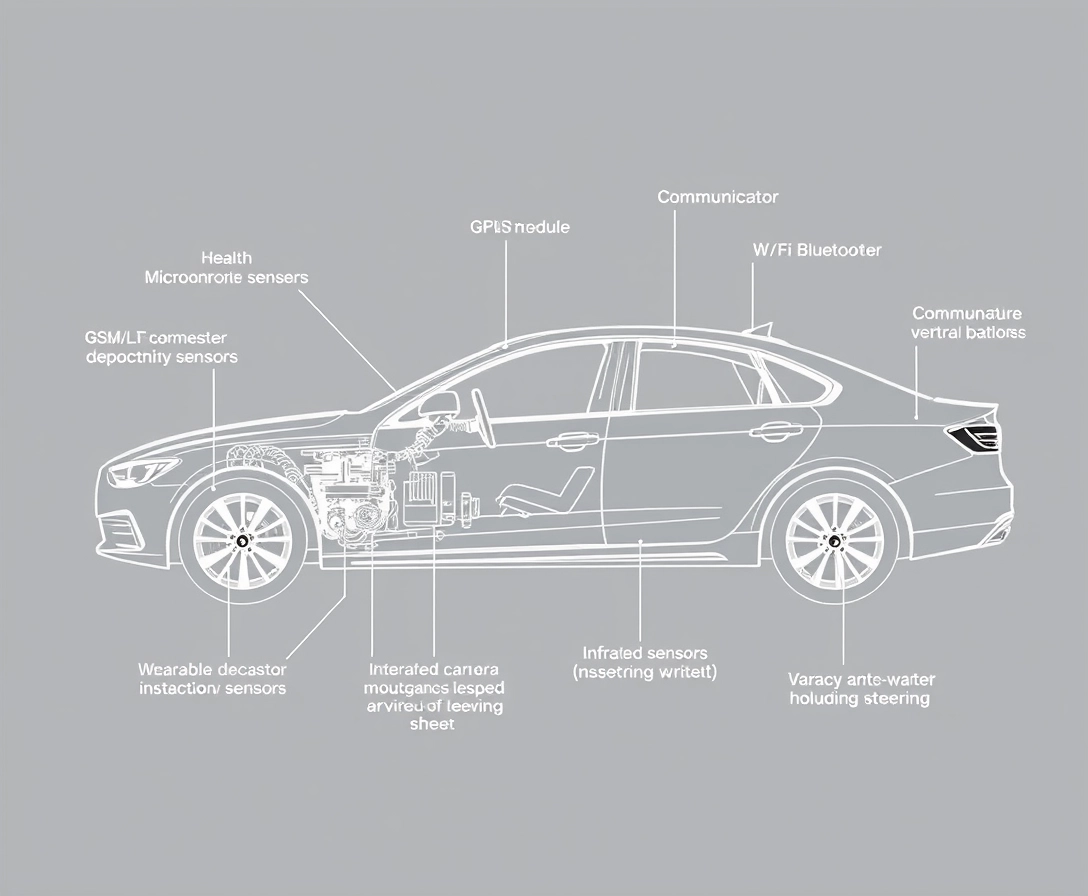KI-Bild erstellt von Flux AI Image Generator

Aufforderung
Create a detailed hardware name that is very clear in a black and white sketch of a car equipped with an advanced accident alert system, focusing on the hardware components and their specific installation locations. The microcontroller/processor should be shown mounted under the dashboard or in a central control unit. Illustrate the accident detection sensors, with the accelerometer and gyroscope integrated into the vehicle’s central control unit or under the dashboard, and impact sensors placed at strategic points around the vehicle (front, rear, and sides). Depict the communication modules, including the GSM/LTE module under the dashboard or in the central control unit, and the Wi-Fi/Bluetooth module integrated with the microcontroller. Show the GPS module mounted on the dashboard or integrated into the vehicle’s navigation system. Include the health monitoring devices, such as wearable health devices worn by the driver on their wrist, an infrared camera mounted on the dashboard facing the driver, pressure sensors integrated into the steering wheel, and a heart rate monitor embedded in the driver’s seat or steering wheel. Display the power supply with the battery pack mounted in the trunk or under the rear seat. Illustrate the user interface components, including the LCD/TFT display mounted on the dashboard within the driver’s line of sight, a buzzer/alarm integrated into the dashboard, and LED indicators positioned on the dashboard. Show the data storage with the SD card module integrated with the microcontroller/processor. Additionally, depict the necessary wiring connecting all components, running neatly through the vehicle. The sketch should clearly depict the placement of each hardware component within the car, providing a comprehensive visual representation of their integration in the accident alert system.
Bildanalyse
Emotionale Analyse
Anwendungsszenarien
Real-time Accident Detection
Beschreibung: Accident Detection and Alert System
Potenzielle Verwendung: This scenario utilizes the accident detection sensors to trigger automated alerts in the event of a collision, notifying emergency services and providing location details.
Health Monitoring Integration
Beschreibung: Driver Health Monitoring
Potenzielle Verwendung: Wearable health devices and pressure sensors are used to monitor the driver's vital signs, ensuring they remain alert and healthy while driving.
GSM/LTE Communication Module
Beschreibung: Emergency Communication
Potenzielle Verwendung: In case of an accident, the GSM/LTE module sends an automated text message or call to emergency contacts with the car's GPS location.
Driver Notification System
Beschreibung: User Interface for Alerts
Potenzielle Verwendung: The LCD/TFT display and buzzer notify the driver of any health issues detected or system alerts, ensuring immediate awareness.
Incident Data Storage
Beschreibung: Data Recording and Review
Potenzielle Verwendung: The SD card module records accident data, allowing for later review, analysis, or insurance claims.
Technische Analyse
Qualitätsbewertung: High-quality components with strategic placements ensuring functionality and user safety.
- Comprehensive sensor array for accident detection
- Wearable health devices for real-time monitoring
- Dual communication modules (GSM/LTE and Wi-Fi/Bluetooth)
- Clear interface for user notifications and alerts
- Efficient data management via SD card storage
- Integration of more advanced sensors
- Battery efficiency improvements
- Enhanced connectivity options